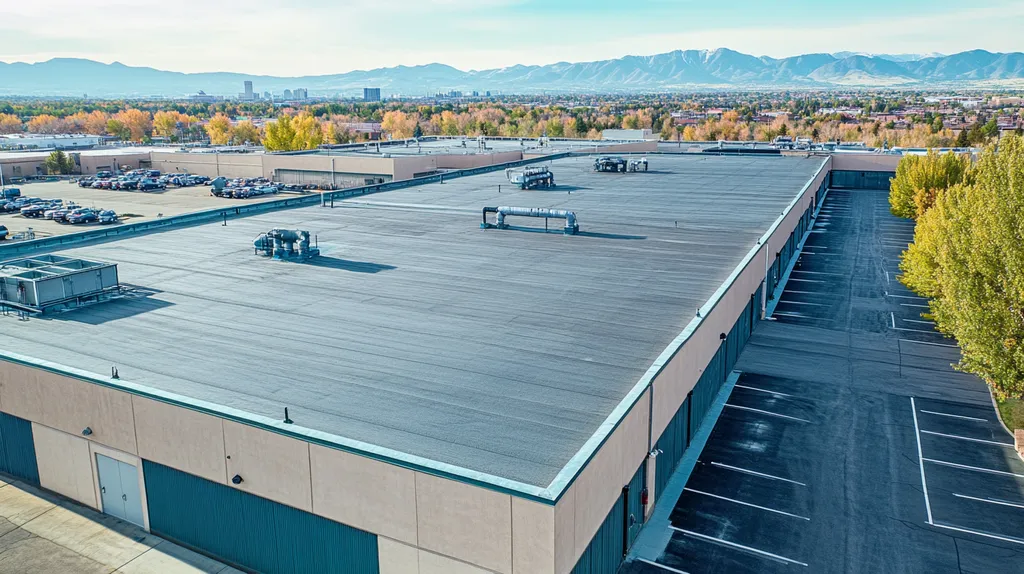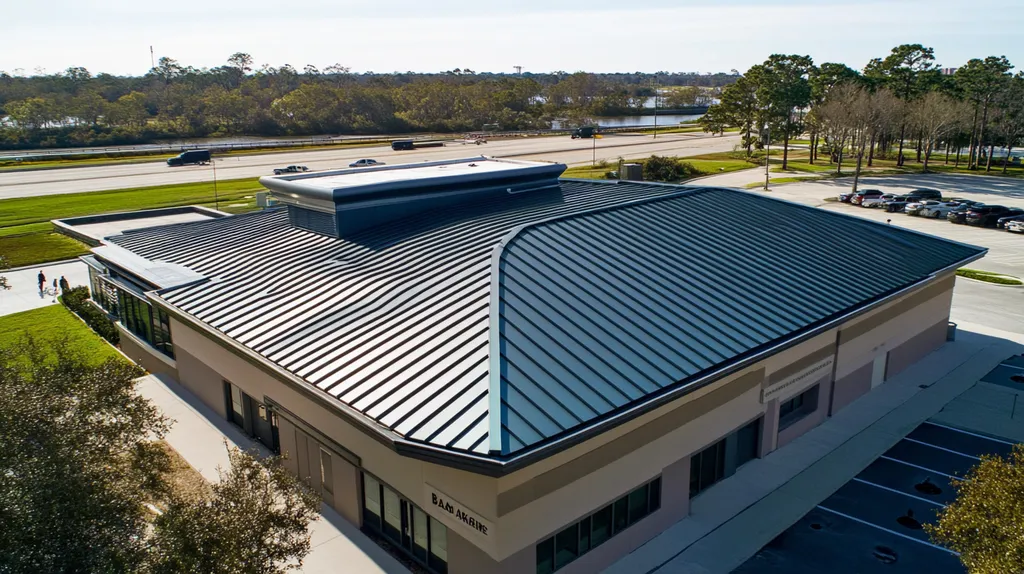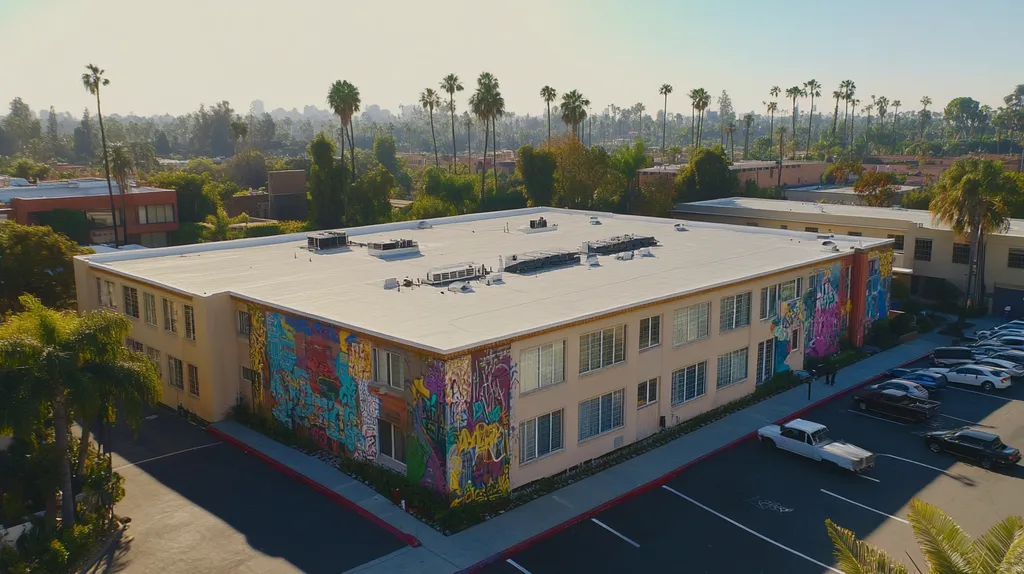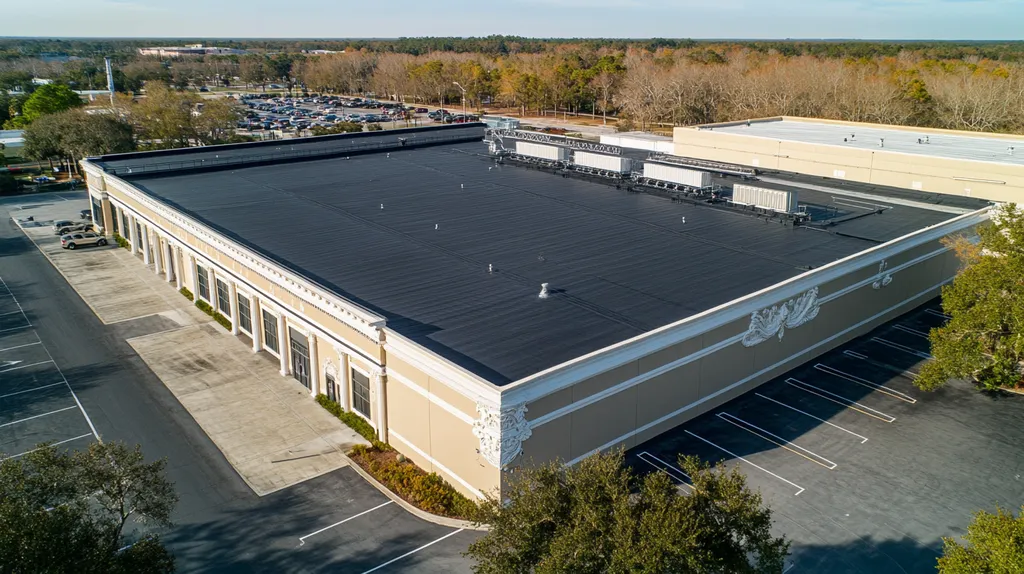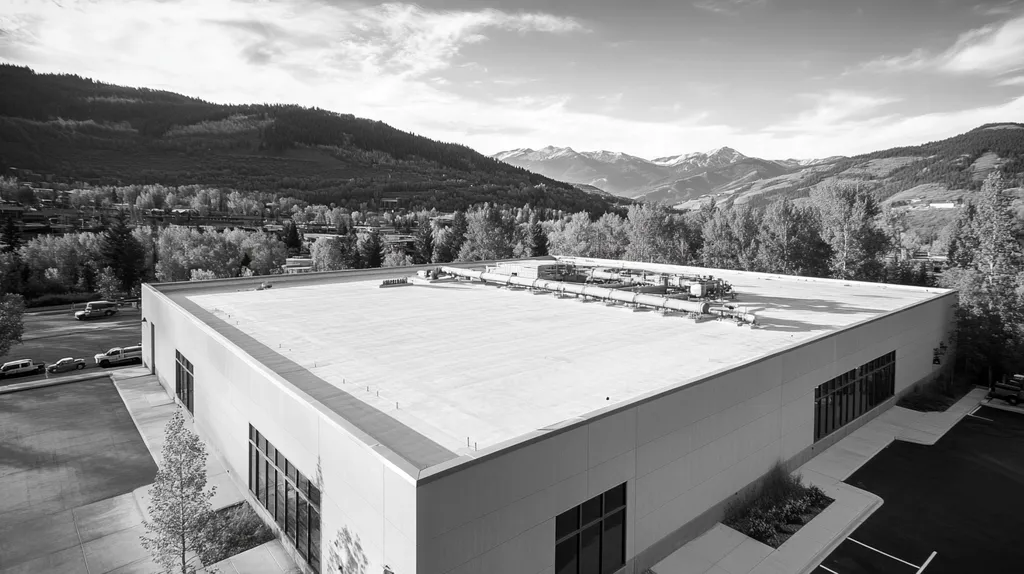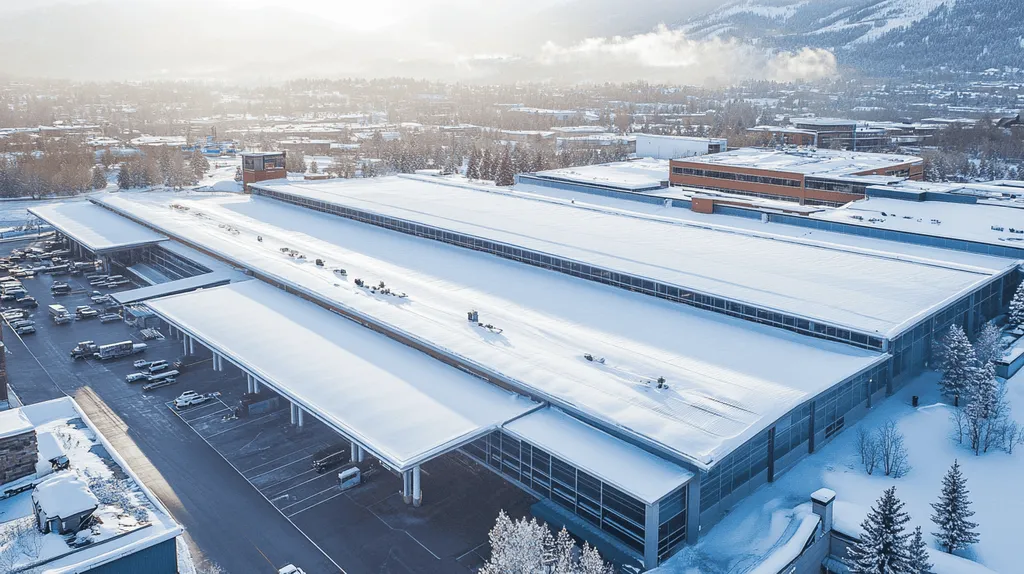Welcome to today’s Battle Royale featuring two roofing heavyweights: “Torch Down” in the east corner versus “PVC Roofing” in the west!
Tonight’s showdown pits these contenders against each other across six punishing rounds designed to test every aspect of their performance for Historical Guidelines for Renovations to a Commercial Roof.
At stake? Millions in potential costs, decades of building protection, and the critical performance demands of modern commercial and industrial facilities.
Our professional judging panel will evaluate each round on technical merit, real-world performance, and value delivery. After all six rounds, we’ll declare our ultimate champion.
Ladies and gentlemen, facility managers and building owners… it’s time to rumble!
ROUND 1: INITIAL COSTS & INSTALLATION
When evaluating commercial roofing options, making informed decisions about materials and installation methods can mean the difference between a successful renovation and costly failures. Historical guidelines from preservation authorities emphasize the importance of choosing compatible materials that maintain both functionality and architectural integrity.
Material Expenses
The replacement of extensively deteriorated roofing components requires careful consideration of material compatibility and long-term performance. When selecting replacement materials, property owners must balance historical accuracy with modern durability requirements. (source: National Park Service)
Torch down roofing materials typically cost $3.50 to $6.50 per square foot, making them an economical choice for budget-conscious renovations. Their straightforward composition and widespread availability contribute to their cost-effectiveness.
PVC roofing materials range from $6.00 to $9.50 per square foot, reflecting their advanced manufacturing processes and enhanced durability features. While more expensive initially, these materials often meet stricter preservation guidelines for substitute materials.
Based on initial material costs alone, torch down roofing holds the clear ADVANTAGE in this category.
Installation Complexity
Installation procedures significantly impact both project success and compliance with historical guidelines. The complexity of installation can affect not only immediate costs but also long-term maintenance requirements.
Torch down roofing installation follows relatively straightforward procedures, requiring basic roofing skills and standard equipment. This simplicity typically results in faster completion times and lower labor costs.
PVC roofing demands specialized installation techniques and equipment, including heat-welding tools and precise seam work. These requirements often lead to higher labor costs and the need for specifically certified installers.
Given the simpler installation process, torch down roofing claims the ADVANTAGE in installation complexity.
Project Timeline
Project duration directly impacts both cost and disruption to building operations. Efficient timeline management becomes crucial when coordinating with preservation requirements and weather constraints.
Torch down installations typically complete in 25-35% less time than comparable PVC projects. This efficiency stems from simpler application techniques and fewer specialized processes.
PVC installations require additional time for proper surface preparation, precise measurements, and quality control checks. These necessary steps ensure long-term performance but extend the overall project timeline.
For timeline efficiency, torch down roofing secures another clear ADVANTAGE.
ROUND 1 WINNER: Torch Down Roofing
ROUND 2: DURABILITY & LIFESPAN
When selecting roofing materials for commercial properties, durability and lifespan considerations directly impact long-term operational costs and building preservation. Historical guidelines emphasize that proper material selection can prevent premature failure and maintain architectural integrity over decades of service.
Understanding the performance characteristics of different roofing systems helps property owners make informed decisions that balance modern durability requirements with preservation standards.
Weather Resistance
The Texas Historical Commission emphasizes that proper material selection is crucial for maintaining both structural integrity and historical authenticity in commercial properties. Their guidelines outline specific approaches for preservation while meeting modern performance requirements. (source: Texas Historical Commission)
Torch down roofing demonstrates excellent resistance to UV radiation and extreme temperature fluctuations. Its modified bitumen composition creates a waterproof barrier that effectively shields against rain and snow, though it can become brittle over time in extremely cold climates.
PVC roofing systems offer superior resistance to chemical exposure and maintain flexibility across a wider temperature range. Their heat-welded seams create a monolithic surface that prevents water infiltration and resists wind uplift more effectively than torch down alternatives.
For overall weather resistance, PVC roofing claims the ADVANTAGE.
Impact Protection
Commercial roofs must withstand various forms of impact stress, from maintenance foot traffic to falling debris. Impact resistance directly affects maintenance costs and system longevity.
Torch down roofing provides good puncture resistance due to its multiple reinforced layers. However, its surface can be damaged by sharp objects and may require more frequent repairs in high-traffic areas.
PVC membranes offer excellent tear resistance and maintain their protective properties even under heavy foot traffic. Their enhanced durability and superior puncture resistance result in fewer maintenance requirements over time.
In impact protection, PVC roofing secures another ADVANTAGE.
Service Life Expectancy
Long-term performance directly impacts return on investment and building preservation strategies. Understanding expected service life helps property owners plan for future renovations.
Torch down roofing typically delivers 15-20 years of service when properly maintained. Regular inspections and prompt repairs are essential to achieve maximum lifespan.
PVC roofing systems routinely last 20-30 years, with some installations exceeding three decades. Their superior chemical resistance and UV stability contribute to extended service life with minimal maintenance requirements.
For service life expectancy, PVC roofing claims the final ADVANTAGE.
ROUND 2 WINNER: PVC Roofing
ROUND 3: PERFORMANCE FACTORS
The performance characteristics of commercial roofing systems directly impact building protection, operational costs, and long-term maintenance requirements. Before undertaking any roofing renovation, property owners must carefully evaluate how different systems will perform under their specific conditions and requirements.
With roofing failures accounting for millions in property damage annually, understanding performance differences between systems becomes critical for protecting valuable assets and maintaining building operations.
Environmental Adaptability
Before proceeding with any roofing renovation, property owners must evaluate how different systems handle their specific environmental challenges. The National Park Service emphasizes that thorough inspections and material compatibility assessments should guide all roofing decisions to ensure long-term performance. (source: National Park Service)
Torch down roofing exhibits strong resistance to UV exposure and temperature fluctuations, but can become brittle in extreme cold. Its modified bitumen composition creates an effective waterproof barrier that performs well in most climate conditions.
PVC roofing maintains consistent performance across a wider range of temperatures and weather conditions. Its chemical resistance and heat-welded seams provide superior protection against environmental stresses, including acid rain and industrial pollutants.
For environmental adaptability, PVC roofing claims the ADVANTAGE.
System Integration
Modern commercial roofs must integrate seamlessly with various building systems, including HVAC units, solar installations, and drainage components. The ability to accommodate these elements without compromising performance is crucial.
Torch down roofing requires careful detailing around penetrations and equipment mounts. While it can accommodate most rooftop installations, special attention must be paid to flashing and sealing at transition points.
PVC systems offer superior flexibility for integrating with modern building components. Their hot-air welded seams and specialized accessories create reliable connections around equipment while maintaining system integrity.
In system integration capabilities, PVC roofing takes the ADVANTAGE.
Load-Bearing Capacity
Commercial roofs must support various loads, including maintenance traffic, equipment weight, and potential future installations. Load-bearing capacity affects both immediate functionality and future adaptation potential.
Torch down roofing provides adequate support for typical rooftop equipment and occasional maintenance traffic. However, its load distribution characteristics may require additional reinforcement for heavy equipment installations.
PVC roofing systems demonstrate superior structural support capabilities and better load distribution. Their enhanced durability and resistance to compression make them ideal for roofs with frequent access requirements or heavy equipment loads.
For load-bearing capacity, PVC roofing secures another ADVANTAGE.
ROUND 3 WINNER: PVC Roofing
ROUND 4: MAINTENANCE REQUIREMENTS
Effective maintenance strategies can mean the difference between a commercial roof lasting its full intended lifespan or failing prematurely. Industry data shows that over 80% of commercial roofs fail before their warranty expiration due to inadequate maintenance protocols. Understanding the maintenance requirements of different roofing systems is crucial for protecting both the building and its historical integrity.
Inspection Requirements
The National Park Service emphasizes that thorough inspections and understanding of historical materials must precede any maintenance work on commercial roofs. This approach ensures preservation of both structural integrity and historical value while preventing unnecessary repairs. (source: National Park Service)
Torch down roofing requires quarterly inspections to identify potential issues like seam separation, blistering, or surface deterioration. These inspections must focus particularly on areas around penetrations and flashings where water infiltration commonly occurs.
PVC roofing systems typically need only bi-annual professional inspections due to their superior durability and resistance to common failure points. Their heat-welded seams remain stable over time, reducing the frequency of required checks.
For inspection requirements, PVC roofing claims the ADVANTAGE.
Repair Complexity
Repair procedures directly impact both maintenance costs and building operations. Simple repairs that can be completed quickly minimize disruption to building occupants and reduce overall maintenance expenses.
Torch down repairs often require specialized equipment and extensive preparation, including careful surface cleaning and proper temperature control. Even minor repairs can become complex operations requiring professional intervention.
PVC systems allow for straightforward repairs using heat-welding techniques that create permanent bonds. Most repairs can be completed quickly without extensive surface preparation or specialized materials.
In repair complexity, PVC roofing takes another clear ADVANTAGE.
Preventive Maintenance Costs
Regular preventive maintenance represents a significant portion of total roofing system ownership costs. Understanding these requirements helps property owners budget effectively for long-term care.
Torch down roofing demands frequent preventive maintenance, including regular recoating and seam reinforcement. These ongoing requirements typically result in higher annual maintenance costs throughout the system’s lifespan.
PVC roofing systems require minimal preventive maintenance beyond routine cleaning and inspection. Their inherent durability and resistance to environmental damage reduce the need for frequent interventions.
For preventive maintenance costs, PVC roofing secures the final ADVANTAGE.
ROUND 4 WINNER: PVC Roofing
ROUND 5: SUSTAINABILITY CREDENTIALS
With commercial buildings accounting for nearly 40% of global energy consumption, roofing choices significantly impact both environmental sustainability and operational costs. Modern facility managers must balance preservation requirements with growing pressure to reduce carbon footprints and energy usage.
Understanding the environmental impact of roofing materials has become crucial as regulations tighten and stakeholders demand greater accountability in building operations. The right choice can lead to decades of reduced environmental impact while supporting historical preservation goals.
Environmental Impact
The National Park Service emphasizes that understanding the environmental impact of roofing materials is crucial for both preservation and sustainability efforts. Their guidelines recommend evaluating both immediate and long-term environmental consequences when selecting replacement materials. (source: National Park Service)
Torch down roofing systems produce significant volatile organic compounds (VOCs) during installation and repairs. Their petroleum-based composition and shorter lifespan result in more frequent replacements, contributing to landfill waste.
PVC roofing offers superior environmental performance through its recyclability and longer service life. Modern PVC formulations have eliminated many historical environmental concerns while maintaining durability.
For environmental impact, PVC roofing claims the ADVANTAGE.
Energy Performance
Energy efficiency directly impacts both operational costs and environmental footprint. Roofing choices can significantly affect building cooling loads and overall energy consumption.
Torch down roofing typically absorbs more solar radiation, leading to increased heat transfer into buildings. This characteristic results in higher cooling costs and greater energy consumption during warm weather.
PVC roofing systems feature superior solar reflectance and thermal emittance properties. Their reflective surface reduces cooling loads and helps minimize urban heat island effects.
In energy performance, PVC roofing takes another clear ADVANTAGE.
Material Longevity
The sustainability of roofing materials extends beyond their initial environmental impact to include their useful life and disposal requirements. Longer-lasting materials reduce replacement frequency and associated environmental impacts.
Torch down roofing typically requires replacement every 15-20 years, generating substantial waste. Their modified bitumen composition makes recycling difficult and often results in materials being sent to landfills.
PVC roofing systems maintain their performance characteristics for 25-30 years or more. Their complete recyclability at end-of-life further reduces environmental impact.
For material longevity, PVC roofing secures the final ADVANTAGE.
ROUND 5 WINNER: PVC Roofing
ROUND 6: SPECIALIZED APPLICATIONS
Commercial roofing applications in specialized settings demand careful consideration of both historical preservation and modern performance requirements. Studies show that up to 40% of specialized commercial roofs fail prematurely due to improper material selection for their specific use case.
Different industrial environments, from food processing facilities to chemical plants, place unique demands on roofing systems that can dramatically impact their longevity and effectiveness.
Chemical Resistance Requirements
The National Park Service emphasizes that understanding material compatibility is crucial when selecting roofing systems, particularly in specialized commercial applications where exposure to chemicals and industrial processes is common. Their guidelines highlight how roofing material selection has evolved to meet increasingly complex industrial demands. (source: National Park Service)
Torch down roofing shows limited resistance to chemical exposure, particularly with industrial solvents and oils. Its modified bitumen composition can deteriorate when exposed to harsh chemicals, leading to premature membrane failure.
PVC roofing demonstrates exceptional chemical resistance across a broad spectrum of industrial compounds. Its formulation specifically resists degradation from industrial exhaust, chemical spills, and atmospheric pollutants.
For chemical resistance, PVC roofing claims the ADVANTAGE.
Industrial Load Requirements
Modern industrial facilities often require roofing systems capable of supporting heavy equipment, frequent maintenance traffic, and specialized installations. Load-bearing capacity directly impacts both immediate functionality and future adaptation potential.
Torch down roofing provides adequate support for standard industrial loads but may require additional reinforcement for heavy equipment. Its layered structure can compress under sustained heavy loads, potentially compromising water-tightness.
PVC roofing systems offer superior structural support and better load distribution characteristics. Their enhanced durability and resistance to compression make them ideal for industrial applications with heavy equipment loads.
In industrial load requirements, PVC roofing takes the ADVANTAGE.
Process Integration Capabilities
Industrial roofing systems must effectively integrate with various process components, including ventilation systems, industrial exhausts, and specialized equipment mounts. Poor integration can compromise both roofing performance and facility operations.
Torch down roofing requires extensive detailing around industrial penetrations and equipment mounts. While it can accommodate most installations, maintaining water-tightness at transition points demands careful attention and ongoing maintenance.
PVC systems excel at integrating with industrial components through their heat-welded seams and specialized accessories. Their flexibility and superior sealing capabilities ensure reliable connections around complex industrial installations.
For process integration capabilities, PVC roofing secures the final ADVANTAGE.
ROUND 6 WINNER: PVC ROOFING
AND THE WINNER IS…
After six grueling rounds of technical analysis, the judges’ scorecards are in, and we have a decisive victory by technical knockout – PVC ROOFING claims the championship belt with an impressive 5-1 round advantage!
PVC dominated the competition through superior durability, lower maintenance requirements, outstanding sustainability credentials, and unmatched performance in specialized applications. Its heat-welded seams, chemical resistance, and longer service life proved virtually unstoppable in the ring.
But don’t count Torch Down out completely! This seasoned veteran still packs a powerful punch in Round 1, delivering lower initial costs and faster installation times. For projects where budget constraints are the primary concern and long-term performance is less critical, Torch Down remains a viable contender.
However, we must emphasize that every building presents unique challenges. Local climate conditions, specific usage requirements, and individual property characteristics can significantly impact roofing performance. While this analysis provides general guidance, property owners should always consult qualified roofing professionals who can evaluate their specific situation before making a final decision.
Ladies and gentlemen, in the high-stakes world of commercial roofing, remember: The true champion isn’t the system with the most impressive stats – it’s the one that best matches your building’s unique requirements and preservation goals.
FREQUENTLY ASKED QUESTIONS
Q. What are the initial costs for a commercial roof?
A. Initial costs for a commercial roof vary by material. Torch down roofing is typically more economical, while PVC roofing costs more upfront but offers long-term benefits. Choosing the right material depends on balancing budget with durability and compliance needs.
Q. How does durability differ between torch down and PVC roofing?
A. The durability of torch down roofing usually lasts 15-20 years, while PVC roofing can last 20-30 years or longer. Proper maintenance is crucial for both materials to ensure optimal performance and longevity over time.
Q. What performance factors should I consider for an industrial roof?
A. Important performance factors for an industrial roof include weather resistance, load-bearing capacity, and environmental adaptability. Each of these factors affects the roof’s overall effectiveness, especially under heavy traffic or exposure to harsh conditions.
Q. How often should a commercial roof be inspected?
A. For torch down roofing, inspections should occur quarterly to identify potential issues, while PVC roofs typically require bi-annual inspections. Regular checks help maintain integrity and prolong the lifespan of the roofing system.
Q. What are the sustainability advantages of PVC roofing?
A. PVC roofing offers sustainability advantages such as recyclability and longer service life, reducing its environmental footprint. It performs well with low energy consumption, making it a smart choice for facility managers focused on environmental responsibility.
Q. How well do these roofing types integrate with solar installations?
A. PVC roofs tend to integrate better with solar installations due to their flexibility and heat-welded seams, ensuring reliable connections. Torch down roofs require more meticulous detailing, potentially complicating future installations or renovations.
Q. What is the average lifespan of torch down roofing?
A. Torch down roofing typically lasts between 15 to 20 years, depending on maintenance and environmental conditions. Regular inspections and repairs are essential to maximize its lifespan and maintain its protective qualities.

